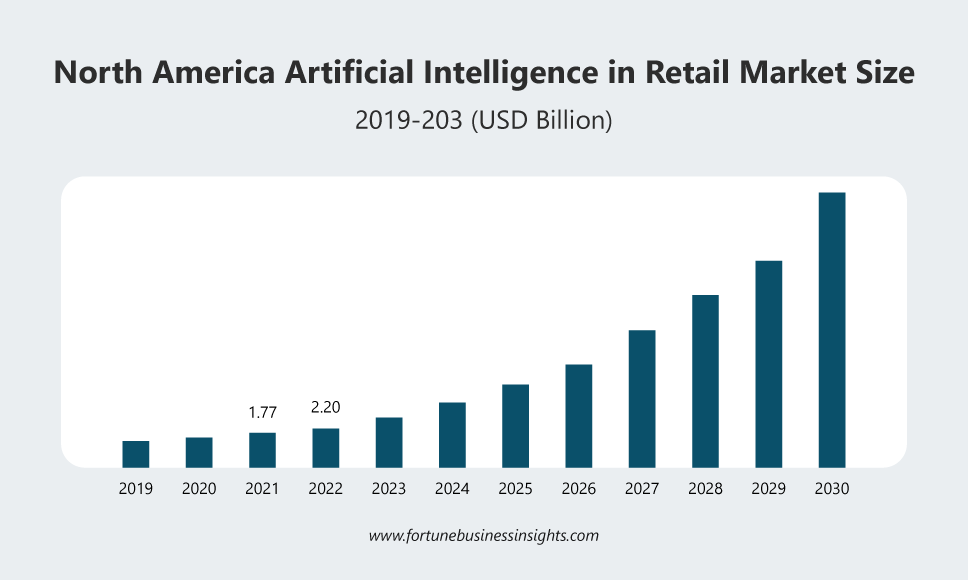

Building a Clear View of Your Customers
The infographic highlights the key challenges faced by businesses as they create a customer view through unified data, analytics, and more.
Download the InfographicThe retail industry and AI are a great match. Retailers collect vast amounts of data, and that’s where AI can shine. For the past several years, major retailers and brands have been implementing AI technology and that is only expected to increase as additional players and smaller companies get in on the action.
What does the future hold for retailers who want to take advantage of AI? How is technology making its mark today and what will that look like in the next few years?
Slow Initial Growth Expected to Swell
Check out this illustration which shows how the retail AI market began to grow slowly in 2019, and is poised to swell through the year 2030.

These growth projections are driven by many factors— an increasing number of internet users and smart devices, rising awareness about AI and big data analytics, and the need for retailers to streamline processes and enhance the end-user experience. Looking ahead, the adoption of AI in the retail industry is expected to leap from 40 percent of companies currently to more than 80 percent in three years, according to Modor Intelligence’s AI in Retail Market Analysis report.
Let’s look at how AI is helping retailers now, and then, let’s take a virtual crystal ball and gaze into the future, starting with personalization.
Hyper Personalization
The more you buy and browse at retail websites, the more retailers are beginning to understand your needs and preferences. AI is already a fundamental piece of how big companies are creating personalization campaigns based on targeted consumer needs, wants and expectations.
With enormous catalogs and a vast array of products, retailers often find it difficult to provide exactly what the shopper is looking for. Think: I meant men’s slim-fit, blue-striped shirt, not shirts with horizontal stripes, not all blue shirts, not big and tall striped shirts. This leads to increased bounce rates and abandoned journeys. It can be like looking for a needle in a haystack.
With AI and machine learning, retailers can enrich product catalogs with metadata, categorization and personalized recommendations, resulting in more relevant search results for customers. So, when you type striped shirts, you get exactly that. It can be further refined to personalize your results to the types of shirts you traditionally shop for: button-down, pullover, etc.
With the amplified focus on customer experience, more and more companies will be jumping into the journey to craft new experiences— and personalization will be at the core. As those efforts, and the machine learning models that generate the insights become more refined, the outputs can be hyper personalized, for example, personalized web pages for customers based on past purchases and search history. So, tailored shopping won’t be a luxury. It is the future.
Sentiment Analysis
AI-powered sentiment analysis is revolutionizing the way businesses interact with customers. Sentiment analysis examines text mined from a wide variety of sources, including online forums, social media platforms (Twitter, Facebook and LinkedIn), chatbot conversations, support tickets, blog posts, emails and third-party websites.
To date, the majority of sentiment analysis projects have been conducted by companies and brands using social media data, survey responses and other areas of user-generated content. The future will likely dig deeper, past the number of likes, comments and shares, to better understand the significance of social media interactions and what they tell us about the consumers behind the screens.
While sentiment analysis is a method that’s nowhere near perfect, as more data is generated and fed into machines, they will continue to get smarter and improve the accuracy with which they process that data. With that knowledge, businesses will be able to better gauge an individual customer’s sentiment and target marketing, sales and product strategies accordingly.
Fine-tuned Forecasting and Planning
One of the most significant challenges in retail operations is accurately predicting customer demand and managing inventory levels to meet that demand. Traditional tools were not designed to perform with large amounts of data so they are typically run weekly or multiple times a week, making it hard to react to disruptions. With modern data architecture and technology, modeling can be run in near real time, providing the planners with the insights they need to adjust and minimize the impact of a disruption.
AI forecasting goes beyond predicting demand by offering prescriptive insights to recommend optimal actions. By considering various constraints— inventory levels, production capacity, and pricing strategies— prescriptive analytics can provide actionable recommendations to optimize inventory management, pricing, and promotions.
Notably, Walmart Global Tech is using AI in retail to improve product predictions. For instance, during the last holiday season, AI helped Sam’s Club predict the number of pumpkin pies that would be needed during the busiest season of the year. Their AI model used a wide variety of data like local temperatures (hot weather often means less pies bought); whether the Sunday football game is home or away (home games can mean more pies are needed); how popular are pecan pies this year (more pecan pies can translate into less pumpkin pie sales). Those data points, and others, plug into an artificial intelligence model they’ve made. It spits out recommendations to each store leader, such as how many pies need to be on-hand in their shops by the hour.
Chatbots Mature
One of the most common or known uses of AI has been in the development of chatbots, virtual assistants, and voice assistants. Intelligent, or AI-infused chatbots, combine real-time learning with algorithms that optimize their ability to communicate based on each conversation held, allowing them to adapt and improve over time.
It’s revolutionized the way retailers interact with their customers and provide support because bots can handle routine inquiries, provide instant responses, and offer personalized recommendations. And bots don’t sleep— they are available round-the-clock, providing assistance and reducing customer wait times.
AI chatbots are equipped with natural language processing (NLP) and machine learning (ML) that helps the chatbots learn from the customer inquiries and dynamically adjust to provide more meaningful prompts and responses. This not only improves customer satisfaction but enables customer service agents to focus on more productive activities. For example, many clothing retailers are using ‘virtual stylists’ which are AI-powered chatbots that ask customers, for example, about size, fit, or material, and then use that information to provide quick answers or suggestions.
Power Virtual Agents (PVAs) are an AI-based tool from Microsoft that empowers anyone in your business to build versatile, adaptable chatbots, with no coding or AI expertise required. The agents can be built in minutes using a graphical interface. PVAs are being touted by Microsoft as a quick way to see what AI can do for you. A trial version is available here.
As AI technologies continue to evolve, chatbots are poised to become even more intelligent and capable. They will revolutionize how businesses engage with their audience, streamline operations, and create unparalleled user experiences. The smarter a Virtual Agent or Chatbot becomes through machine learning, the more tailored its conversations can be. It’s back to personalization, in a sense.
Don’t Lose Sight of the Human Element
In the process of making retail business operations more intelligent, AI has the potential to make brands more human by enabling marketers to focus increased time and energy on listening, creativity, empathy, culture, and community. At the end of the day, AI should make us better people, professionals, and brands.
Don’t lose sight of the human element, and the importance of it. Technologies like chatbots may lack the practical insight needed to handle complex issues and be aware of the context of a conversation, leading to responses that could frustrate customers. Because they aren’t human, they can make mistakes regarding a customer’s emotions, intent or tone.
Generative AI technology may serve best as a copilot rather than a self-contained solution. For instance, rather than sending an AI-generated email without reading it, it’s far more effective to use it to speed up the crafting of a personalized response. The tool can generate the bulk of the content, but the salesperson is the one who makes it truly personal and practical.
Get Started with AI Technologies
Artificial Intelligence (AI) is making a real impact across many industries, with retail being at the forefront. While it’s exciting, the applications of tomorrow are even more thought provoking. Imagine a CPG executive seeking a quick overview of the month’s sales metrics, supply chain inefficiencies, or inventory levels. Instead of waiting for compiled reports, the executive could query an advanced AI system that would not only present the required data, but it could also offer insights, trends, and suggestions.
It sounds great, and the tools are cool and exciting, but how do you get started? The quickest, easiest, and most cost-effective way is with a partner, like Hitachi Solutions. Our team has deep experience in operations, relationship management, business analytics, and user collaboration. As a leader in digital transformation, we understand how critical AI innovation is for today’s retail industry.
For questions on how Hitachi Solutions can help your business reach the next level, contact us today. Ultimately, AI won’t merely enhance productivity—it will serve as a cornerstone for transformative growth and long-term success.


